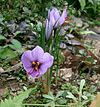Wikipedia:Today's featured article/September 29, 2007
The trade and use of saffron reaches back more than 3,000 years and includes marketing for medicinal, culinary, and colourative applications. Saffron, a spice derived from the dried stigmas of the saffron crocus, has remained among history's most costly comestibles. With its bitter taste, hay-like fragrance, and slight metallic notes, saffron has been used as a seasoning, fragrance, dye, and medicine. Saffron is native to Southwest Asia, but was first cultivated in Greece. In both antiquity and modern times, most saffron was and is used in the preparation of food and drink: cultures spread across Africa, Asia, Europe, and the Americas value the red threads for use in such items as baked goods, curries, and liquor. Medicinally, saffron was used in ancient times to treat a wide range of ailments, including stomach upsets, bubonic plague, and smallpox; clinical trials have shown saffron's potential as an anticancer and anti-aging agent. Saffron has been used to colour textiles and other items, many of which carry a religious or hierarchical significance. (more...)
Recently featured: Saint Henry – Smallville Pilot – Hannah Primrose, Countess of Rosebery
